
As rapid advancements in technology continue to transform various industries around the world, education in Australia is experiencing an important paradigm shift.
Perhaps one of the most encouraging changes has been the shift to online and cloud-based platforms, assisting schools in providing accessible learning to more students.
Another positive shift, according to the Productivity Commission, is that advancements in technology are allowing teachers “to focus on core teaching functions to improve the quality of teaching”.
With that in mind, Samsung – one of the world’s most forward-thinking technology powerhouses – has been offering a range of cutting-edge solutions.
Modern solutions for the modern classroom
“Innovation in technology has led to a significant growth in capabilities and practices across schools, ultimately improving learning outcomes for students,” Phil Gaut, Senior Director of Display, and Brand Memory, Samsung Electronics Australia, told The Educator.
Gaut said that as lesson plans become increasingly digitised, the large, high-resolution screens and powerful front and rear speaker audio of Samsung’s Flip Interactive Display, make that content clear, and keep students engaged all the way to the back of the classroom.
“Additionally, the intuitive touch panel, realistic pen-to-paper writing style, and handy built-in templates and embedded tools help bring lessons to life,” he said.
Gaut noted that tools such as these facilitate the kind of simple connectivity many schools are trying to embed in their classrooms.
“With student content coming from an increasingly diverse range of sources the Flip Interactive Display is incredibly simple to use, plus it features built-in open-source software and multiple connectivity options,” he said. “This makes connecting and sharing lesson plans and student content easy.”
Slaying the administrative beast
Samsung is also helping senior school leaders manage the changes that come with tech-driven innovation in education, with Gaut saying the philosophy of ‘simple connectivity’ extends into relieving some of the administrative burden.
“The digitisation of administration and compliance requirements, automation of processes, and centralised content management systems saves time and improves communication,” he said.
“For example, a centralised content management system can be used to change content on a digital signage network across an entire campus, providing real-time updates for students, teachers and parents with just a few clicks.”
Moreover, says Gaut, the provision of agnostic open-source software means that schools are not locked into any one system, giving them the flexibility to switch between different platforms.
“Samsung has incorporated a few clever features for teachers. The Freeze mode on the Flip Pro pauses everything displayed on the screen, allowing teachers to use their computers without students seeing their activity,” Gaut explained.
“This offers an opportunity for teachers to catch up on emails, research, or prepare for the next lesson.”
Samsung’s Flip Interactive Display also includes a privacy screen feature, which pulls a shutter down on the display, giving teachers the ability to walk away while keeping content safe from prying eyes.
“Schools are increasingly looking for one display brand they can trust for all their display needs across their campuses,” Gaut said.
“Samsung has been the number one selling global digital signage brand for 13 consecutive years, making it a reliable choice for educational institutions.”*
Bridging the digital divide
Covid-19 highlighted Australia’s growing ‘digital divide’, an issue that many schools – particularly those in regional, rural, and remote areas – are continuing to struggle with.
However, Gaut said he sees some key opportunities for Australia’s education system to become more equitable in this critical area.
“Many states are upgrading their network infrastructure to provide better access to digital learning environments.” Gaut said.
“Samsung is also playing an important role in helping to close the digital divide in Australian education by offering cost-effective hardware at different price points and now available to buy directly, which helps remove the affordability barrier.” Learn more here
*Samsung has been the No.1 selling digital signage brand for 13 consecutive years by Omdia. Consumer TVs, along with Commercial Lite and Hospitality TVs used for signage are excluded


